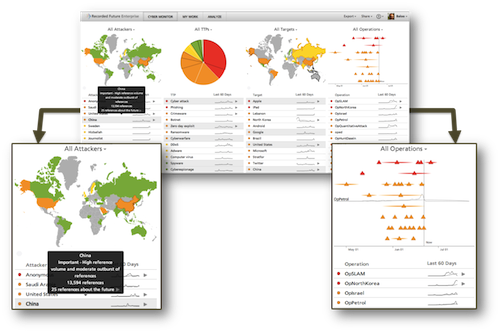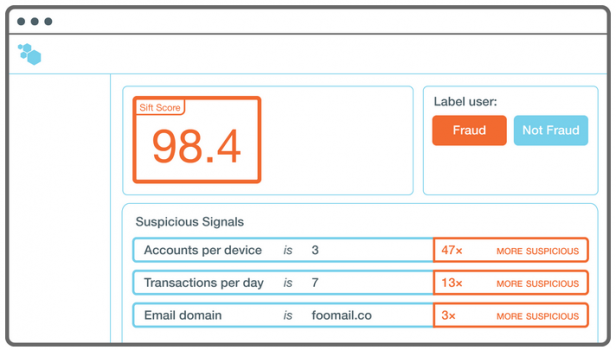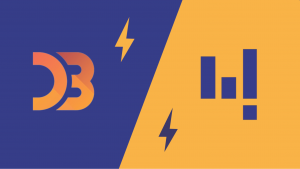In part 1 of this series on predictive analytics, we discussed the variety of data, particularly unstructured and semi-structured data, and the three types of predictive analytics. We also touched upon the approach of continual optimization of a predictive analytics system for it to become more and more accurate. With those basic concepts in place, we’re ready to take a tour of the various applications of predictive analytics as it’s used in businesses today. You can think of this as the hall of fame of predictive analytics.
- Recorded Future – The hottest startup to leverage predictive analyticsRecorded Future uses the web to help their customers anticipate risks and capitalize on opportunities. It produces web intelligence signals from news, blogs, and public social media which are constantly crawled. Users can search for people, and upcoming events, or any keyword, and sort the results by a particular country or time in the future, say two weeks from now. This information can be used to keep track of political conflicts, changes in the economy, and product launches. However, the most prominent use of Recorded future is to anticipate and respond to cyber attacks before they happen. This has been the holy grail of cyber security, something that even SRI are working on, and Recorded Future is showing promise in this area.
 The viability of this service is evident with investment from the likes of Google, and an analyst firm working for the CIA. In fact, it’s being used by the US government right now, to get intelligence on the crisis in Syria, to find out if the Syrian Electronic Army (SEA) is linked to Iranian hacker groups. In this initiative, Recorded Future evaluated 300,000 Web sources, including websites popular with hackers, for information on the rise of the SEA from their beginnings in 2011 to the present. It concluded that there were differences in attack patterns between Iranian and Syrian groups, and ruled out a connection between them.
If there’s one company that’s fast becoming the poster child of predictive analytics today, it’s Recorded Future. Here’s a fun video explaining how Recorded Future works:
The viability of this service is evident with investment from the likes of Google, and an analyst firm working for the CIA. In fact, it’s being used by the US government right now, to get intelligence on the crisis in Syria, to find out if the Syrian Electronic Army (SEA) is linked to Iranian hacker groups. In this initiative, Recorded Future evaluated 300,000 Web sources, including websites popular with hackers, for information on the rise of the SEA from their beginnings in 2011 to the present. It concluded that there were differences in attack patterns between Iranian and Syrian groups, and ruled out a connection between them.
If there’s one company that’s fast becoming the poster child of predictive analytics today, it’s Recorded Future. Here’s a fun video explaining how Recorded Future works: - Sift Science – Predictive analytics for smarter e-commerce websitesAnother startup innovating in the cyber security space, is Sift Science. Unlike Recorded Future, it has a more defined target audience – e-commerce websites. It monitors e-commerce websites in real-time, and provides alerts on fraudulent activity. Online fraud is a nagging pain for any business that transacts online, and can cost companies not just hard revenue, but tremendous resources too. While traditionally, cyber security is an expensive, complex initiative, Sift Science makes state of the art security more accessible to e-commerce websites.
 While what they’re doing is important, it’s the ‘how’ part that we’re interested in. Sift Science uses big data, and machine learning to assign a fraud score to users. Since it’s based on machine learning, the method of prediction isn’t set, but rather, adapts to fraudsters’ changing tactics. While this methodology is very capable in itself, Sift Science delivers the knockout punch by leveraging the 1 million different fraud patterns from its database of customers, and applies that combined intelligence to each individual customer.
The company claims that the system today can detect up to 90 percent of the fraud happening on its customers’ sites, which is an impressively high accuracy rate. This can be a huge cost benefit to customers, and the investors concur.
While what they’re doing is important, it’s the ‘how’ part that we’re interested in. Sift Science uses big data, and machine learning to assign a fraud score to users. Since it’s based on machine learning, the method of prediction isn’t set, but rather, adapts to fraudsters’ changing tactics. While this methodology is very capable in itself, Sift Science delivers the knockout punch by leveraging the 1 million different fraud patterns from its database of customers, and applies that combined intelligence to each individual customer.
The company claims that the system today can detect up to 90 percent of the fraud happening on its customers’ sites, which is an impressively high accuracy rate. This can be a huge cost benefit to customers, and the investors concur. - UberAds – Predictive analytics for a new wave in advertisingIt’s not just the new kids on the block who want to have a shot at a predictive analytics startup. Bill Gross, the father of pay-per-click search ads, went back to the drawing board and came up with a targeted mobile ad platform, UberAds, which uses predictive modeling to decide which ads are most relevant a particular user. UberAds uses more than 10,000 targeting parameters from public social networks, combines this with location, and time of day information from users’ mobile phones, and runs algorithms on this data to serve up the right ad at the right time. While ad platforms have always sought to be non-intrusive, relevant, and even desirable to consumers, the combination of mobile devices, and predictive analytics promises to give advertising a leap as significant as the shift from banners to pay-per-click search ads. Here’s a video of Bill Gross himself explaining how UberAds works, with an interesting example of how it can show a targeted movie ad to a Tom Cruise fan at just the right time.
- Target Data – Predictive analytics ain’t always sexy, but may be just rightWhile all the previous companies are innovating in uncharted territory, Target Data is unique in that it seeks to overhaul an entrenched industry with the magic of predictive analytics. What Target Data does is to predict the likelihood that a home will sell in the next 30, 60 or 90 days based on a multitude of publicly available listings. It analyzes this information to create a profile of the house being sold and the stage of the sale (i.e., early, middle, late in the cycle) and pass this data to customers. Armed with this information, businesses like realtors, packers and movers, and parallel services like telecom service providers, cable operators, local contractors, and a host of agents, can deliver targeted marketing communication to prospects in advance. Target Data CEO, Ross Shelleman believes that the time of moving a home is the best time for marketers to wean off prospects from competitors, or reinforce loyalty to their own brand. He also admits that Target Data doesn’t gather any new data, but what it does is to build a sophisticated system of aggregating, and sorting existing data to make it usable for its customers. What Target Data does may not be sexy, but it’s an inspiring example of how predictive analytics is being used to revitalize traditional businesses. Here’s an interview of Ross Shelleman, where he takes us behind the scenes with Target Data:
- SalesPredict – Predictive lead scoring for today’s sales teamsOur last company in the list is SalesPredict, which is a fully automated lead scoring SaaS solution aimed at helping Sales Teams focus their effort on the leads that are most likely to convert. It looks at Salesforce data, social data and other information sources, such as website traffic from Alexa and data.com. This data is then used to automatically characterize the attributes that differentiate a good lead from one that is less likely to be fruitful. Over time, the predictive model gets updated to account for changes in the lead pool. While the giants in the industry like Salesforce, and Marketo tackle this problem in some way, SalesPredict’s value lies in its use of predictive analytics to to make lead scoring automatic and smarter. One of the co-founders of SalesPredict, Kira Radinsky, is actively involved in academics related to predictive analytics. She recently teamed up with Eric Horvitz from Microsoft on a project to predict disease outbreaks by scanning two decades of New York Times articles, and other online data like Wikipedia. They used tools like DBpedia, WordNet, and OpenCyc to analyze text content and understand the semantic relationship between words. The result was a prediction model with 70 to 90 percent accuracy, which if developed further can be invaluable to social outreach organizations, and health institutions. Kira starts her Ph.D abstract with a quote from Mark Twain that ‘the past does not repeat itself, but it rhymes.’ Here’s an audio interview of Kira that may not be of the best quality, but if you’ve read this far you may be inspired by her passion for predictive analytics.


